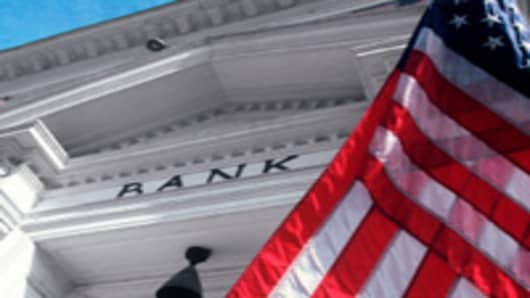U.S. regulators told top banks to raise $74.6 billion to build a capital cushion officials hope will restore faith in financial firms and set a course out of the deepest recession in decades.
Within minutes of release of the bank "stress test" results, which showed smaller capital needs than once feared, several of the 10 firms needing capital immediately issued statements detailing how they planned to raise it.
Bank of America, which accounted for almost half of the total capital shortfall with $33.9 billion to be raised, said it planned to sell assets, issue $17 billion in common stock, and take other steps to fill the hole.
"We're going to be watching carefully to make sure they give us credible plans for raising capital and becoming privately owned again," Federal Reserve
Chairman Ben Bernanke said at a news briefing, referring to the entire group and not just Bank of America.
The results of bank "stress tests" — which involved more than 150 regulatory officials poring over the books of the 19 largest financial firms — effectively drew a line between healthy and weak, and quantified exactly how much those institutions struggling under the weight of souring loans must raise.
The bank reviews, led by the Federal Reserve, showed 10 banks needed additional capital to withstand heavier losses that would likely come if the recession worsened.
In addition to BofA's $33 billion, Citigroup will need $5.5 billion, Wells Fargo $13.7 billion and GMAC $11.5 billion. Morgan Stanley needs to raise $1.8 billion and Regions Financial needs $2.5 billion.
Other big banks do not need to raise any capital, including Bank of New York Mellon, American Express, Capital One Financial, Goldman Sachs Group, JPMorgan Chase, MetLife and State Street. Click here for full results.
Four banks—including Bank of America and Citibank—announced new or expanding stock offeringsas a result of the stress tests.
President Obama's administration hopes the firms can fill the capital holes from private sources, although Fed Chairman Ben Bernanke said the government was prepared to help if needed.
Obama's team appears to have managed financial market expectations well, getting the worst news from the stress tests out two days ago—that Bank of America needed about $34 billion.
The $74.6 billion amount was smaller than some analysts had estimated before the stress tests were finalized.
Regulators had to walk a fine line as they sought to convince skeptical investors the reviews were sufficiently rigorous without unduly straining banks that were already in a precarious financial position.
The total figure also appeared to be small enough to ensure that the White House would not have to approach Congress for more rescue money on top of the $700 billion approved last year—a request that would likely be turned down because of voter outrage over the bailouts.
But skeptics of the administration's bank strategy still abound.
The American Bankers Association criticized the severity of the stress tests and said there was no evidence banks need to change the make-up of their capital. But it said the test results should end "harmful speculation."
Some analysts and investors questioned the credibility of the tests.
"At best, the process may have been a waste of time; at worst, it's something that has caused more confusion," said Mike Holland, chairman of private investment firm Holland & Co, speaking before the test results were officially released.
It is not clear, for example, precisely how banks will have to increase equity capital, he said.
Banks may cover any capital shortfalls through a mixture of asset sales, share sales and perhaps the conversion of preferred shares into common stock.
Regulators have put special emphasis on holding common capital rather than preferred because it can be tapped more quickly if needed.
If a bank raises common equity by converting preferred shares issued under the $700 billion bailout fund, the government could become one of the bank's biggest shareholders.
President Obama's fiscal 2010 budget, unveiled Thursday, includes at $250 billion "placeholder" for additional financial rescue efforts, but White House budget director Peter Orszag said he hopes it will not be necessary to use this money.
The results of stress tests are the culmination of a months-long exercise aimed at reviving the financial system and are expected to show about half the banks need more capital.
The government is focused on banks filling shortfalls in their equity capital—an amount that Goldman Sachs analysts estimated could total $130 billion this year. That estimate included what the stronger institutions would need to raise to pay back government money and funds the weaker ones need to fill shortfalls.
Share prices in banks broadly have climbed about 50 percent since the stress tests were first announced as part of a wider plan to revive the sector in February. But on Thursday, the KBW Banks Index slumped 4.8 percent, and some investors viewed the stress test results as spelling an end to that rally.
"From my perch, investors should sober up and reduce their holdings in financials now," hedge fund manager Doug Kass said in a note to clients. "Financial stocks are now priced to perfection." In an interview, Kass said he is selectively selling short some bank stocks.
Federal Reserve Chairman Ben Bernanke described the tests as a fair and comprehensive effort that he hoped would allow markets to have "greater confidence that they know the condition of the banks."
"(Markets) can be reassured that banks will be strong and be able to lend even if the economy is worse than currently expected," he said.
The tests "remove some cloud of uncertainty from this chapter of the banking industry saga," said Craig Peckham, equity trading strategist at Jefferies & Co in New York.
—Reuters and AP contributed to this report.



